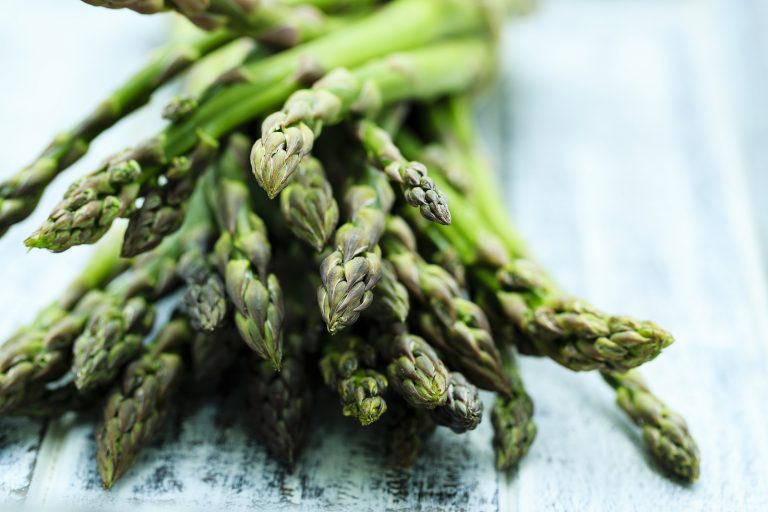Asparagus, low in calories and high in protein and fiber, is also simply loaded with potassium and folic acid. A perennial vegetable particularly suited to Arizona’s climate, soil conditions, and moisture, it can live up to 15 years. It also thrives with minimal care, and welcomes raised beds (i.e., where soil can be added over the crowns of the plants).

Asparagus also has some very weird characteristics, but first, the health benefits. With a mere 20 calories in five spears and 2.3 grams of protein, asparagus is highly nourishing. Doubtful shoppers, or those who have never tasted asparagus, can no doubt find some locally (in Yuma, Maricopa, or Pinal – three of the 13 Arizona Farm Bureau member counties). One taste is sure to convince!
Asparagus does flower, but the flowers are typically so small – stems or spikes of white, six-petalled flowers – that they are noticeable only when in full bloom. The flowering forms of asparagus are a different cultivar; densiflorus rather than officinalis, with the common name Asparagus Fern, and an annual rather than perennial habit.
Of course, this depends on the type. Those who forage for wild asparagus, Asparagus officinalis, know that the flower spikes are an indication that the spears will already be bitter. These connoisseurs prefer to mark the patch and come back in the early spring.
Cultivated, or hybrid, asparagus, typically does not flower. That is because the plants have been domesticated to include all (or mostly) males. It is probably the only species in the plant kingdom where male species are purposely selected, and these hybrids are sold under names like Millennium, Mondeo, Pacific Purple, Pacific 2000, and Stewart Purple.
White asparagus is not a hybrid but a way of growing asparagus. In the dark, mounded with soil (so that the stalks grow without chlorophyll), this premium form of asparagus – reportedly sweeter than the green variety – will still produce green leaves and flower stalks above ground.
White asparagus is higher in carbs, but so very few it can still be part of a healthy diet, even one for type 2 diabetics. At 3 grams of carbs but 2 grams of fiber (which reduces the glycemic index), white is better at delivering a daily helping of “green” than an equivalent amount of peas, for example.
If you are watching calories or carbs, you can keep both low by blanching, steaming, or microwaving asparagus. If you don’t think your family will enjoy it plain, reserve a portion and make the rest more palatable by choosing delicious recipes like Goat Cheese Lettuce Wraps, or the scrumptiously spicy Julie’s Oven Roasted Red Potatoes & Asparagus.
Now for the weird stuff:
- The name, which comes from Greek, means something whose origin is unknown, or obscure, but Late Medieval writer William Pepys called it “sparrowgrass”.
- Biochemists have isolated sulfur-containing compounds in asparagus that cause urine to smell weird. Don’t worry, you aren’t sick, it is just your kidneys breaking down the asparagusic acid – a chemical found only in asparagus.
- Asparagus etiquette dictates serving the vegetable on a ceramic plate (something to do with its acid content, no doubt). Oddly enough, dedicated asparagus serving forks and tongs, especially the antique variety, are made of ivory, silver, and gold plate.
- The Romans started to cultivate asparagus more than 2,000 years ago. By that time, it was familiar (as food or medicine) to the Spanish, the Syrians, and the Egyptians. It arrived in Northern California in the 1850s, along with the California Gold Rush – luxury food for miners who had struck it rich.
- Asparagus is good for a hangover! The proof is scientific but the discovery probably dates to antiquity. Modern conclusions about its ability to cure cancer, prevent or heal fungal infections, prevent inflammation, and eliminate excess water, can be found in the medical literature.
- Asparagus is a love potion! Wikipedia, via an Arabic source, confirms this. A newer document dismisses the notion. Seems the rarity of the item, and (in the case of white) its high cost, influence the psychology of the receiver more than any potential hormones being stimulated.
Related articles
- 10 Amazing Things about Asparagus (fillyourplate.org)
- Julie’s Oven Roasted Red Potatoes & Asparagus (fillyourplate.org)
- Using Food to Fight Stress (fillyourplate.org)

